The global blade-type belt cleaners market is valued at USD 99.6 million in 2025. It is slated to reach USD 136.5 million by 2035, recording an absolute increase of USD 36.9 million over the forecast period. This translates into a total growth of 37.0%, with the market forecast to expand at a compound annual growth rate (CAGR) of 3.2% between 2025 and 2035. The overall market size is expected to grow by nearly 1.37X during the same period, supported by increasing demand for efficient material handling systems in mining and bulk material processing operations, growing adoption of conveyor belt cleaning solutions that reduce material carryback and spillage, and rising emphasis on operational efficiency and workplace safety standards across diverse mining, manufacturing, and logistics applications.
Between 2025 and 2030, the blade-type belt cleaners market is projected to expand from USD 99.6 million to USD 116.6 million, resulting in a value increase of USD 17.0 million, which represents 46.1% of the total forecast growth for the decade. This phase of development will be shaped by increasing automation of material handling systems in industrial facilities, rising demand for maintenance-friendly cleaning solutions that reduce downtime, and growing utilization of advanced blade materials in harsh operating environments. Mining operators and industrial facility managers are expanding their belt cleaning capabilities to address the growing demand for reliable and cost-effective solutions that ensure conveyor system performance and reduce cleanup requirements.
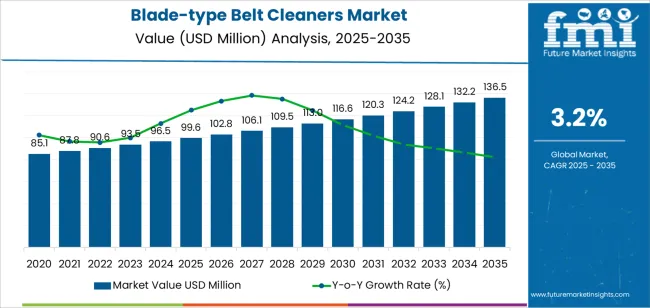
From 2030 to 2035, the market is forecast to grow from USD 116.6 million to USD 136.5 million, adding another USD 19.9 million, which constitutes 53.9% of the overall ten-year expansion. This period is expected to be characterized by the expansion of smart conveyor monitoring technologies that integrate with belt cleaning systems, the development of specialized blade designs for specific material handling applications, and the growth of preventive maintenance programs incorporating regular belt cleaner inspection and replacement. The growing adoption of environmental compliance initiatives and dust control strategies will drive demand for blade-type belt cleaners with enhanced cleaning efficiency and durability characteristics.
Between 2020 and 2025, the blade-type belt cleaners market experienced steady growth, driven by increasing emphasis on conveyor system efficiency in mining operations and growing recognition of belt cleaners as essential components for reducing material spillage, minimizing conveyor wear, and maintaining clean operating environments. The market developed as maintenance engineers and operations managers recognized the potential for effective belt cleaning systems to reduce cleanup labor costs, prevent material buildup, and extend conveyor component service life while meeting safety and environmental requirements. Technological advancement in blade materials and mounting systems began emphasizing the critical importance of maintaining consistent cleaning pressure and blade contact across diverse conveyor applications and operating conditions.
| Metric | Value |
|---|---|
| Estimated Value in (2025E) | USD 99.6 million |
| Forecast Value in (2035F) | USD 136.5 million |
| Forecast CAGR (2025 to 2035) | 3.2% |
Market expansion is being supported by the increasing global demand for efficient bulk material handling systems in mining, agriculture, and industrial processing sectors driven by production volume requirements and operational cost pressures, alongside the corresponding need for effective belt cleaning solutions that can minimize material carryback, reduce spillage cleanup requirements, and maintain conveyor system performance across various coal handling, aggregate processing, and manufacturing applications. Modern mining operators and industrial facility managers are increasingly focused on implementing blade-type belt cleaner systems that can reduce maintenance labor, improve workplace cleanliness, and provide consistent cleaning performance in demanding operating environments.
The growing emphasis on workplace safety and environmental compliance is driving demand for belt cleaning solutions that can reduce dust generation, minimize slip hazards from material spillage, and ensure comprehensive housekeeping standards. Industrial operators' preference for cleaning systems that combine effective performance with installation simplicity and maintenance efficiency is creating opportunities for innovative blade-type cleaner implementations. The rising influence of conveyor system optimization initiatives and total cost of ownership considerations is also contributing to increased adoption of belt cleaners that can provide reliable material removal without compromising belt life or operational uptime.
The market is segmented by cleaner type, application, and region. By cleaner type, the market is divided into primary belt cleaners and secondary belt cleaners. Based on application, the market is categorized into mining, agriculture, food & beverage, manufacturing, logistics/warehousing, and others. Regionally, the market is divided into East Asia, Europe, North America, South Asia, Latin America, Middle East & Africa, and Eastern Europe.
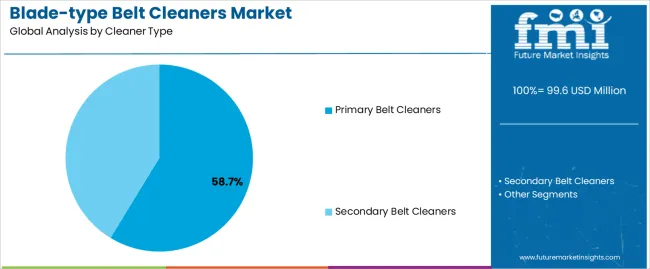
The primary belt cleaners segment is projected to maintain its leading position in the blade-type belt cleaners market in 2025 with a 58.7% market share, reaffirming its role as the preferred cleaning solution for initial material removal at conveyor discharge points. Mining operators and bulk material handling facilities increasingly utilize primary belt cleaners for their critical positioning at head pulleys, effective removal of bulk material carryback, and proven effectiveness in preventing material adhesion to return belt surfaces while reducing secondary cleaning requirements. Primary cleaner technology's established performance advantages and installation versatility directly address the industry requirements for efficient material removal that prevents carryback accumulation and maintains clean conveyor operations across diverse material types and conveyor configurations.
This cleaner type segment forms the foundation of comprehensive belt cleaning systems, as it represents the component with the greatest contribution to overall cleaning effectiveness and established installation standards across multiple conveyor applications and operating conditions. Mining industry investments in conveyor system optimization continue to strengthen adoption among operators and facility managers. With increasing focus on reducing spillage cleanup costs and maintaining housekeeping standards, primary belt cleaners align with both operational efficiency objectives and safety requirements, making them the central component of comprehensive conveyor maintenance strategies.

The mining application segment is projected to represent the largest share of blade-type belt cleaners demand in 2025 with a 42.8% market share, underscoring its critical role as the primary driver for belt cleaner adoption across coal mining, metal ore processing, and aggregate production operations. Mining operators prefer blade-type belt cleaners due to their robust construction suitable for harsh environments, ability to handle abrasive materials, and capacity to operate continuously in high-volume material handling systems while supporting productivity objectives and maintenance efficiency. Positioned as essential components for mining conveyor systems, blade-type belt cleaners offer both operational benefits and cost advantages.
The segment is supported by continuous expansion of mining operations and the growing implementation of conveyor system best practices that prioritize material carryback control with enhanced cleaning efficiency and reduced maintenance requirements. Additionally, mining companies are investing in comprehensive belt cleaning programs to support environmental compliance initiatives, workplace safety improvements, and operational cost reduction efforts focused on minimizing material spillage and cleanup labor. As mining production volumes increase and conveyor systems expand, the mining application will continue to dominate the market while supporting advanced cleaning technologies and system optimization strategies.
The blade-type belt cleaners market is advancing steadily due to increasing demand for efficient material handling systems driven by mining production expansion and growing implementation of conveyor maintenance best practices that require cleaning technologies providing effective carryback removal and operational reliability across diverse coal handling, mineral processing, and bulk material transport applications. The market faces challenges, including competition from alternative cleaning technologies and scraper systems, price sensitivity in cost-constrained mining operations, and technical limitations related to blade wear rates and replacement frequency in highly abrasive material applications. Innovation in blade materials and mounting system designs continues to influence product development and market expansion patterns.
The growing expansion of mining activities and bulk material processing facilities is driving demand for reliable belt cleaning systems that address increased conveyor utilization, higher material throughput requirements, and extended operating hours in continuous production environments. Mining applications require blade-type belt cleaners that deliver consistent cleaning performance across diverse material characteristics while maintaining operational reliability and minimizing maintenance intervention. Mining operators are increasingly recognizing the cost advantages of effective belt cleaning for reducing spillage cleanup expenses, preventing material buildup, and maintaining conveyor system efficiency, creating opportunities for specialized cleaner designs tailored to specific mining operations and material handling requirements.
Modern belt cleaner manufacturers are incorporating advanced polyurethane formulations, specialized blade geometries, and innovative mounting systems to enhance cleaning effectiveness, extend service life, and reduce maintenance requirements through optimized blade contact pressure and material selection. Leading companies are developing wear-resistant blade compounds for abrasive material applications, implementing tensioning mechanisms that maintain consistent cleaning pressure, and advancing blade designs that accommodate varying belt conditions and material characteristics. These developments improve cleaning performance while enabling new market opportunities, including food-grade applications, high-speed conveyor systems, and specialized material handling environments. Advanced material integration also allows operators to support comprehensive maintenance objectives and operational efficiency beyond traditional cleaning system capabilities.
The expansion of automated conveyor monitoring technologies and predictive maintenance programs is driving demand for belt cleaning systems that integrate with condition monitoring equipment, provide performance feedback, and support maintenance planning through data collection and analysis capabilities. These applications require cleaning systems with sensor compatibility, standardized mounting interfaces, and maintenance-friendly designs that facilitate inspection and replacement procedures, creating market segments with differentiated product specifications and service requirements. Manufacturers are investing in modular system designs and documentation resources to enable integrated maintenance programs while supporting operator training and troubleshooting capabilities.
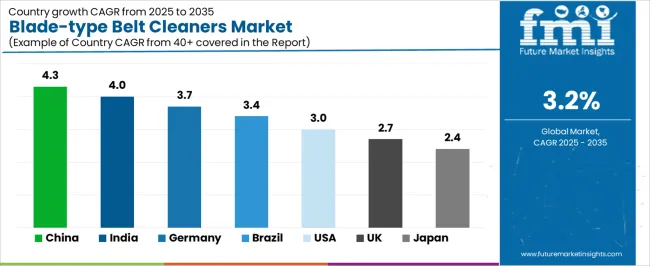
| Country | CAGR (2025-2035) |
|---|---|
| China | 4.3% |
| India | 4.0% |
| Germany | 3.7% |
| Brazil | 3.4% |
| United States | 3.0% |
| United Kingdom | 2.7% |
| Japan | 2.4% |
The blade-type belt cleaners market is experiencing solid growth globally, with China leading at a 4.3% CAGR through 2035, driven by expanding coal mining operations, growing infrastructure development requiring bulk material handling, and increasing investment in conveyor system efficiency improvements. India follows at 4.0%, supported by mining sector expansion, agricultural processing growth, and rising adoption of mechanized material handling systems. Germany shows growth at 3.7%, emphasizing manufacturing excellence, bulk material processing innovation, and engineered conveyor system solutions. Brazil demonstrates 3.4% growth, supported by mining industry development, agricultural commodity handling, and expanding logistics infrastructure. The United States records 3.0%, focusing on mining productivity optimization, material handling system upgrades, and maintenance efficiency improvements. The United Kingdom exhibits 2.7% growth, emphasizing industrial processing applications, logistics facility optimization, and equipment modernization programs. Japan shows 2.4% growth, supported by manufacturing precision, quality-focused maintenance practices, and specialized material handling requirements.
The report covers an in-depth analysis of 40+ countries, the top-performing countries are highlighted below.
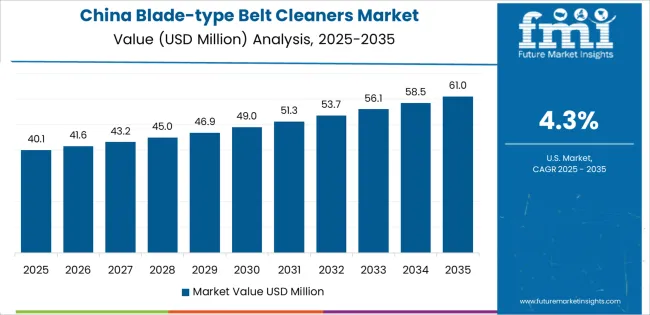
Revenue from blade-type belt cleaners in China is projected to exhibit exceptional growth with a CAGR of 4.3% through 2035, driven by extensive coal mining operations and rapidly expanding bulk material handling infrastructure supported by industrial development programs and energy sector requirements. The country's massive mining industry scale and increasing emphasis on operational efficiency are creating substantial demand for belt cleaning solutions. Major mining operators and material handling equipment suppliers are establishing comprehensive conveyor maintenance programs to serve both state-owned enterprises and private mining operations.
Revenue from blade-type belt cleaners in India is expanding at a CAGR of 4.0%, supported by the country's growing mining sector, expanding agricultural processing infrastructure, and increasing mechanization of bulk material handling in industrial and logistics applications. The country's comprehensive industrial development initiatives and rising operational efficiency focus are driving demand for effective belt cleaning capabilities throughout diverse material handling sectors. Leading mining companies and agricultural processing facilities are establishing maintenance programs and equipment upgrade initiatives to address operational efficiency requirements.
Revenue from blade-type belt cleaners in Germany is expanding at a CAGR of 3.7%, supported by the country's advanced manufacturing sector, bulk material processing expertise, and engineered conveyor system solutions serving diverse industrial applications. The nation's precision engineering capabilities and quality emphasis are driving sophisticated belt cleaning system implementations throughout manufacturing and processing industries. Leading equipment manufacturers and industrial facilities are investing extensively in maintenance optimization and conveyor system performance enhancement.
Revenue from blade-type belt cleaners in Brazil is expanding at a CAGR of 3.4%, supported by the country's significant mining operations, extensive agricultural production, and developing bulk material handling infrastructure for commodity export logistics. Brazil's resource extraction activities and agricultural sector scale are driving demand for reliable belt cleaning solutions. Mining operators and agricultural logistics facilities are investing in conveyor maintenance capabilities to serve domestic processing and international export requirements.
Revenue from blade-type belt cleaners in the United States is expanding at a CAGR of 3.0%, supported by the country's coal mining operations, aggregate production industry, and emphasis on conveyor system optimization for operational efficiency and safety compliance. The nation's established mining sector and industrial processing capabilities are driving demand for effective belt cleaning solutions. Mining operators and aggregate producers are investing in conveyor maintenance programs and equipment upgrades to improve operational efficiency and regulatory compliance.
Revenue from blade-type belt cleaners in the United Kingdom is expanding at a CAGR of 2.7%, driven by the country's industrial processing sector, logistics facility operations, and maintenance optimization initiatives supporting operational efficiency and workplace safety standards. The United Kingdom's industrial infrastructure and safety regulatory framework are driving demand for reliable belt cleaning systems. Manufacturing facilities and logistics operations are investing in conveyor maintenance improvements and equipment modernization programs.
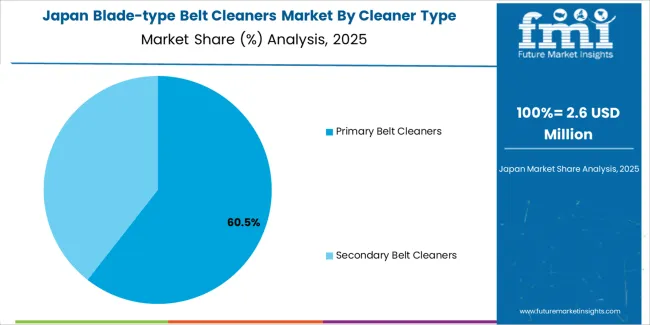
Revenue from blade-type belt cleaners in Japan is expanding at a CAGR of 2.4%, supported by the country's precision manufacturing sector, quality-focused maintenance practices, and specialized material handling requirements in industrial processing applications. Japan's operational excellence culture and equipment reliability emphasis are driving demand for high-quality belt cleaning products. Manufacturing facilities and processing operations are investing in maintenance system optimization and equipment quality enhancement.
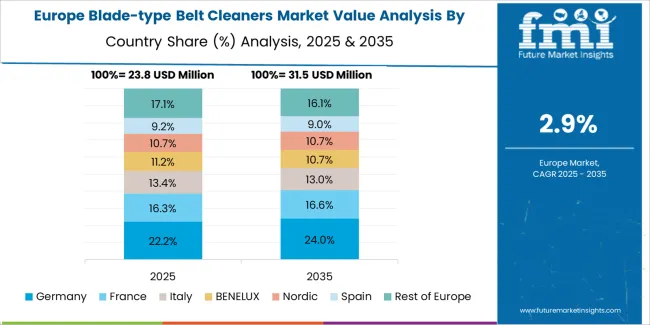
The blade-type belt cleaners market in Europe is projected to grow from USD 37.2 million in 2025 to USD 55.0 million by 2035, registering a CAGR of 4.0% over the forecast period. Germany is expected to maintain leadership with a 28.9% market share in 2025, moderating to 28.4% by 2035, supported by advanced manufacturing infrastructure, bulk material processing expertise, and strong conveyor system engineering capabilities.
The United Kingdom follows with 17.6% in 2025, projected at 17.3% by 2035, driven by industrial processing operations, logistics facility expansion, and maintenance optimization initiatives. France holds 15.3% in 2025, rising to 15.5% by 2035 on the back of mining operations, aggregate production, and industrial material handling requirements. Italy commands 11.8% in 2025, increasing slightly to 12.0% by 2035, while Spain accounts for 9.2% in 2025, reaching 9.4% by 2035 aided by mining activities, agricultural processing, and logistics infrastructure development. The Netherlands maintains 5.4% in 2025, up to 5.5% by 2035 due to port operations, logistics facilities, and bulk material handling systems. The Rest of Europe region, including Nordics, Central & Eastern Europe, and other markets, is anticipated to hold 11.8% in 2025 and 11.9% by 2035, reflecting steady progress in mining operations, industrial processing expansion, and conveyor system optimization programs.
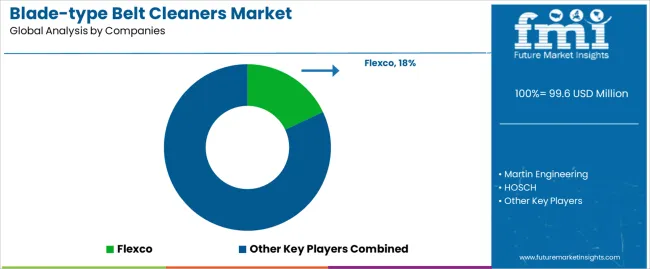
The blade-type belt cleaners market is characterized by competition among established conveyor component manufacturers, specialized belt cleaning solution providers, and diversified material handling equipment companies. Companies are investing in blade material development, mounting system innovation, product portfolio expansion, and application-specific cleaner designs to deliver effective, durable, and cost-efficient blade-type belt cleaner solutions. Innovation in wear-resistant materials, tensioning mechanisms, and installation systems is central to strengthening market position and competitive advantage.
Flexco leads the market with comprehensive belt maintenance solutions with a focus on primary and secondary belt cleaners, innovative blade designs, and global distribution capabilities across diverse mining, aggregate, and industrial applications. Martin Engineering provides advanced belt cleaning systems with emphasis on engineered solutions, application expertise, and comprehensive conveyor component offerings. HOSCH delivers specialized belt cleaning technologies with focus on European markets and industrial applications. Benetech offers belt maintenance products with emphasis on cost-effective solutions and regional market service. Richwood Industries provides conveyor components and belt cleaning systems for mining and industrial sectors.
Rulmeca Group specializes in conveyor components including pulley systems and belt cleaners for integrated material handling solutions. GURTEC focuses on belt cleaning systems and conveyor accessories for industrial applications. LUTZE provides material handling components including belt cleaning solutions for manufacturing sectors. Fenner Dunlop offers conveyor belting products and maintenance accessories including belt cleaners. InduTechnik emphasizes industrial conveyor components and cleaning systems. ASGCO provides comprehensive conveyor solutions including belt cleaning technologies for bulk material handling applications.
Blade-type belt cleaners represent a specialized component segment within bulk material handling and conveyor system maintenance, projected to grow from USD 99.6 million in 2025 to USD 136.5 million by 2035 at a 3.2% CAGR. These material handling components serve as critical maintenance elements in conveyor systems where effective carryback removal, spillage prevention, and system cleanliness are essential. Market expansion is driven by increasing mining production volumes, growing emphasis on operational efficiency, expanding bulk material handling infrastructure, and rising implementation of conveyor maintenance best practices across diverse mining, agricultural processing, manufacturing, and logistics applications.
How Industry Regulators Could Strengthen Safety Standards and Operational Requirements?
How Industry Associations Could Advance Best Practices and Technical Knowledge?
How Belt Cleaner Manufacturers Could Drive Product Innovation and Market Development?
How End-User Facilities Could Optimize Cleaning Performance and Maintenance Efficiency?
How Equipment Distributors Could Support Market Access and Customer Service?
How Maintenance Service Providers Could Enable Operational Excellence?
| Items | Values |
|---|---|
| Quantitative Units (2025) | USD 99.6 million |
| Cleaner Type | Primary Belt Cleaners, Secondary Belt Cleaners |
| Application | Mining, Agriculture, Food & Beverage, Manufacturing, Logistics/Warehousing, Others |
| Regions Covered | East Asia, Europe, North America, South Asia, Latin America, Middle East & Africa, Eastern Europe |
| Countries Covered | China, India, Germany, Brazil, United States, United Kingdom, Japan, and 40+ countries |
| Key Companies Profiled | Flexco, Martin Engineering, HOSCH, Benetech, Richwood Industries |
| Additional Attributes | Dollar sales by cleaner type and application category, regional demand trends, competitive landscape, technological advancements in blade materials, installation system innovation, maintenance optimization strategies, and application performance enhancement |
The global blade-type belt cleaners market is estimated to be valued at USD 99.6 million in 2025.
The market size for the blade-type belt cleaners market is projected to reach USD 136.5 million by 2035.
The blade-type belt cleaners market is expected to grow at a 3.2% CAGR between 2025 and 2035.
The key product types in blade-type belt cleaners market are primary belt cleaners and secondary belt cleaners.
In terms of application, mining segment to command 42.8% share in the blade-type belt cleaners market in 2025.






Full Research Suite comprises of:
Market outlook & trends analysis
Interviews & case studies
Strategic recommendations
Vendor profiles & capabilities analysis
5-year forecasts
8 regions and 60+ country-level data splits
Market segment data splits
12 months of continuous data updates
DELIVERED AS:
PDF EXCEL ONLINE
Belt Trainers Market Size and Share Forecast Outlook 2025 to 2035
Belt File Sander Market Size and Share Forecast Outlook 2025 to 2035
Belt Feeders Market Size and Share Forecast Outlook 2025 to 2035
Cross-Belt Sorters Market
Chamber Belt Vacuum Machine Market Analysis Size and Share Forecast Outlook 2025 to 2035
Packing Belt Market Insights - Growth & Forecast 2025 to 2035
Modular Belt Drive Market
Conveyor Belt Tracking Devices Market Size and Share Forecast Outlook 2025 to 2035
Conveyor Belt Market Size and Share Forecast Outlook 2025 to 2035
Conveyor Belt Materials Market
Ammunition Belt Market Size and Share Forecast Outlook 2025 to 2035
Automotive Belts Market Growth - Trends & Forecast 2025 to 2035
Brush-Type Belt Cleaners Market Size and Share Forecast Outlook 2025 to 2035
Industrial V Belts Market Growth - Trends & Forecast 2025 to 2035
Conveyors and Belt Loaders Market Growth - Trends & Forecast 2025 to 2035
Automotive Seat Belts Market Size and Share Forecast Outlook 2025 to 2035
Rubber Conveyor Belt Market Size, Growth, and Forecast 2025 to 2035
Band File Sander Belts Market Size and Share Forecast Outlook 2025 to 2035
Automotive Timing Belt Market
Demand for Conveyor Belts in EU Size and Share Forecast Outlook 2025 to 2035

Thank you!
You will receive an email from our Business Development Manager. Please be sure to check your SPAM/JUNK folder too.
Chat With
MaRIA